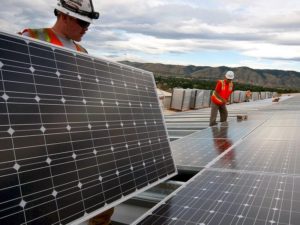[tm_pb_section admin_label=”section”][tm_pb_row admin_label=”row”][tm_pb_column type=”4_4″][tm_pb_text admin_label=”Text” text_orientation=”left” use_border_color=”off” border_color=”#ffffff” border_style=”solid”]
A solar system will not only save you and your tenants money, it will also make you money.
Adding a solar system to a commercial property offers huge benefits to both landlords and their tenants. It’s a tax saving win for landlords who can also benefit from an additional stream of income. And it’s a money saving win for tenants who will pay much lower utility bills. How? Let’s take a look at a typical commercial solar rental scenario:
![]() Joe runs a small manufacturing business and rents a 10,000 square foot building. Last year he paid $21,900 or an average of $1,800/month in PG&E bills. His total usage for the last 12 months is 88,000 kWh’s (kilowatt hours). That means Joe is paying an average of 24.8 cents/kWh for power.
Joe runs a small manufacturing business and rents a 10,000 square foot building. Last year he paid $21,900 or an average of $1,800/month in PG&E bills. His total usage for the last 12 months is 88,000 kWh’s (kilowatt hours). That means Joe is paying an average of 24.8 cents/kWh for power.
If the owner of the building were to install a solar system, the numbers would look something like this:
Offsetting Joe’s energy usage of 88,000 kWh’s/year would require a 53 kW (53,000 watts) solar system. The cash price of the installed roof mount solar system comes to $119,250. The owner would then get a Federal tax credit of $35,775 for the year the system is purchased. If the entire tax credit can’t be used in year one, it can be carried back one year and then forward for up to 20 years until the tax credit is used up. This brings the system cost down to $83,475.
Besides the 30% tax credit, the building owner can also depreciate the cost of the solar system over six years. Based on a Federal tax rate of 33% and a State tax rate of 10.3%, this would mean an additional $43,907 in tax savings. Now the cost of the system is down to $39,568.
The building owner can then make an agreement with the tenant to sell the power created by the solar system at a discounted rate.
This rate can be locked-in for as long as the tenant remains in the building, encouraging the tenant to stay in a long-term lease. Over the years, as PG&E rates go up, the tenant’s fixed rate saves them more and more money.
For example, if the building owner charges 16 cents/kWh, that would come to $1,173/ month or $14,076/year. The tenant would be saving over $600/month in year one and even more money each following year. Even if the landlord charged 18 cents/kWh, that comes out to $1,320/month of additional income for the landlord, and the tenant would still save $480/month in year one.
With the 30% Federal tax credit, equipment depreciation, and income from the tenant, the solar system would be paid off in less than four years. Once the initial investment has been recouped, the power sold to the tenant becomes extra income. That’s an extra $1,173/month (or more) of income with little to no expense. Win-Win!
Contributed by Mike Shaheen, commercial and residential solar expert for CalSun Electric & Solar Systems in Paso Robles. If you would like more information about adding solar to your business or home, please call him directly at (805) 468-9030.
[/tm_pb_text][/tm_pb_column][/tm_pb_row][/tm_pb_section]
